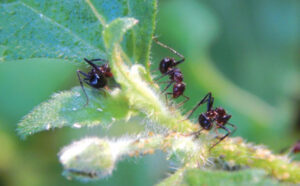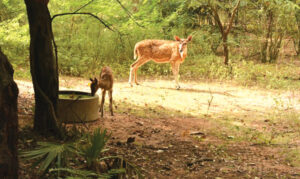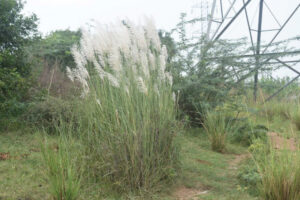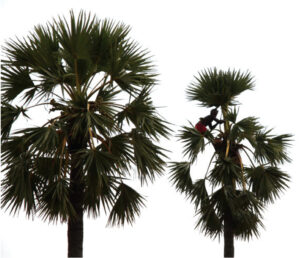Registered with the Registrar of Newspapers for India under R.N.I 53640/91
Vol. XXXI No. 6, July 1-15, 2021
The ecological history of Chennai
by R.J. Ranjit Daniels, N. Muthu Karthick, Anjana Vencatesan and Jayshree Vencatesan

The ant species Myrmicaria brunnea. Photo: Care Earth Trust.
According to legend, King Solomon had a brief encounter with a “valley of ants” and his admiration for them led him to value all life forms. The resilience of ants is seen in the way they quickly adapt to changing conditions of the environment and their ability to colonise new habitats. It is further evident in the fact that there is practically no habitat, including the most developed cities, where there are no ants.
Little is known about the diversity of ants in Chennai and there is a dearth of scientific studies on this. However, from what little is known, there appears to be a unique assemblage of ants in Chennai and its neighbourhood.
Over two decades ago, a single individual of an ant species in the genus Amblypone was collected from a field near Sriperumbudur. Amblypone is a genus of primitive burrowing ants that was earlier known only from the Australian region and in India, locally from the Western Ghats. Although the collection of Amblypone from near Chennai is an important scientific discovery, owing to the lack of follow up research, the significance of the discovery was soon lost. Chances of finding the ant again are bleak as built-up spaces may have destroyed its fragile habitat. Similar to the Amblypone ant, there are many species of plants and animals precariously surviving in small habitat fragments within the rapidly growing city and its suburbs.
Studies by Care Earth Trust have identified nearly 40 species of grasses and sedges in a suburban wetland. These species of grasses may be found locally throughout Chennai. Ecologically, grasses are excellent soil binders, help in recharging groundwater and are fodder to grazing animals, including the Spotted Deer. Some of the genera of grasses found here such as Paspalum spp. (common), Panicum spp. and Echinochloa spp. are wild relatives of minor millets and can contribute to biotechnology research. Others like Aristida spp. belong to the common ‘broom grass’ species. Cynodon dactylon is the popular ‘Arugam pul’, which is a medicinal and considered sacred and also a very good substitute for exotic grasses used in making lawns.
The ecological history of Chennai
A proper understanding of the ecological history of an urban landscape is critical to limiting development to its carrying capacity. Attempts to trace the ecological history of Chennai begin with the question “what was Chennai’s landscape like in the past?” Answering this question enters the realm of speculation based on the biodiversity that has persisted in the city. The biodiversity of Chennai points to the fact that the city evolved from two cultural landscapes – Neithal and Paalai (ecosystems as classified in Sangam or classical Tamil literature) – representing the coast and associated coastal wetlands; and human-impacted degradation of the two cultural landscapes.

Spotted deer in Chennai. Photo: Care Earth Trust.
Paalai is characterised by scattered secondary vegetation, often in the form of dense thickets, dominated by woody plants that bear latex, some of which are adorned with thorns. The cactus-like Euphorbia antiquorum also belongs to this vegetation type. A plant that dominated both the Neithal and Paalai cultural landscapes is the Palmyra palm, a keystone species and the State tree of Tamil Nadu.
As a result, the reconstructed historical landscape of Chennai will be one with a domination of Palmyra and Phoenix palms interspersed with thickets. The intervening spaces would have been covered with a mixture of grasses and short herbs; a condition that allowed surface water flows to move freely without flooding. Trees were sparse and local and most likely the Banyan, if present.

Grass species Saccharum spontaneum, also known as wild sugarcane. Photo: Care Earth Trust.
In fact, the present ‘green’ vegetation of Chennai, dominated by trees locally, is the result of enrichment in the recent past of approximately 50 years. Examples of such enriched vegetation include the campuses of Indian Institute of Technology Madras (IIT-M), the Guindy National Park, the Madras Christian College, the Theosophical Society and the Adyar Poonga.
The speculation that Chennai’s landscape was dominated by the Palmyra palm in the past is supported by the persistence of animals like the Blackbuck, fan-throated lizard, saw-scaled viper and a handful of birds including the laughing dove and the Indian stone curlew. These animals, best adapted to life in semi-desert-like habitats, are now surviving within small fragments of suitable habitats inside Chennai.
There are two possible exceptions to this. First, Chennai’s coast was locally dominated by mangrove and associated species of plants. It is generally accepted by plant ecologists that Mylapore and Nungambakkam sustained dense growth of mangroves till about a 100 years ago. Similarly, it is believed that the famous Luz Church, locally known as ‘Kaattu Kovil’ got its Tamil name after the dense mangroves that surrounded it.
Second, according to the Late Prof. T. N. Ananthakrishnan there were dracos (flying lizards) in the hills of Pallavaram till the late 1940s, making it likely that the hills sustained dense and tall vegetation in the past.
Tree planting as ‘green development’

The ecological history of Chennai points to an abundance of the Palmyra palm, Borassus flabellifer. Photo by Kevin Samuel.
One of the most commonly adapted, yet dangerous forms of green development is to plant trees as a step towards ‘green development’. Landscapes vary locally in the tree-biomass they support and some, such as Chennai, tend to be naturally low in tree-biomass. A cursory glance at some area names in Chennai – Purasawalkam, Pulianthoppu, Perambur, Mandaveli – all named after plants illustrates that these were localities that stood out due to their vegetation. In other words, the uniqueness of the vegetation served as a distinct landmark.
One of the most commonly adapted, yet dangerous forms of green development is to plant trees as a step towards ‘green development’. Landscapes vary locally in the tree-biomass they support and some, such as Chennai, tend to be naturally low in tree-biomass. A cursory glance at some area names in Chennai – Purasawalkam, Pulianthoppu, Perambur, Mandaveli – all named after plants illustrates that these were localities that stood out due to their vegetation. In other words, the uniqueness of the vegetation served as a distinct landmark.
Over-burdening the landscape of Chennai with trees has had adverse consequences. The blackbuck in the IIT-M was almost exterminated by the tree-burden of the campus. Excessive shading and the micro-habitats created by trees could have been responsible for the rapid spread of the Aedes mosquito. The uncontrolled spread of the invasive alien Prosopis juliflora has further increased the tree-burden of Chennai. Their relatively poor transpiration combined with their dense growth and resultant solid waste accumulation causes water stagnation for months after the rains. – Courtesy: https://india.mongabay.com/2020/09/commentary-of-ants-and-antelopes-the-ecological-history-of-chennai-was-not-what-one-would-imagine/

